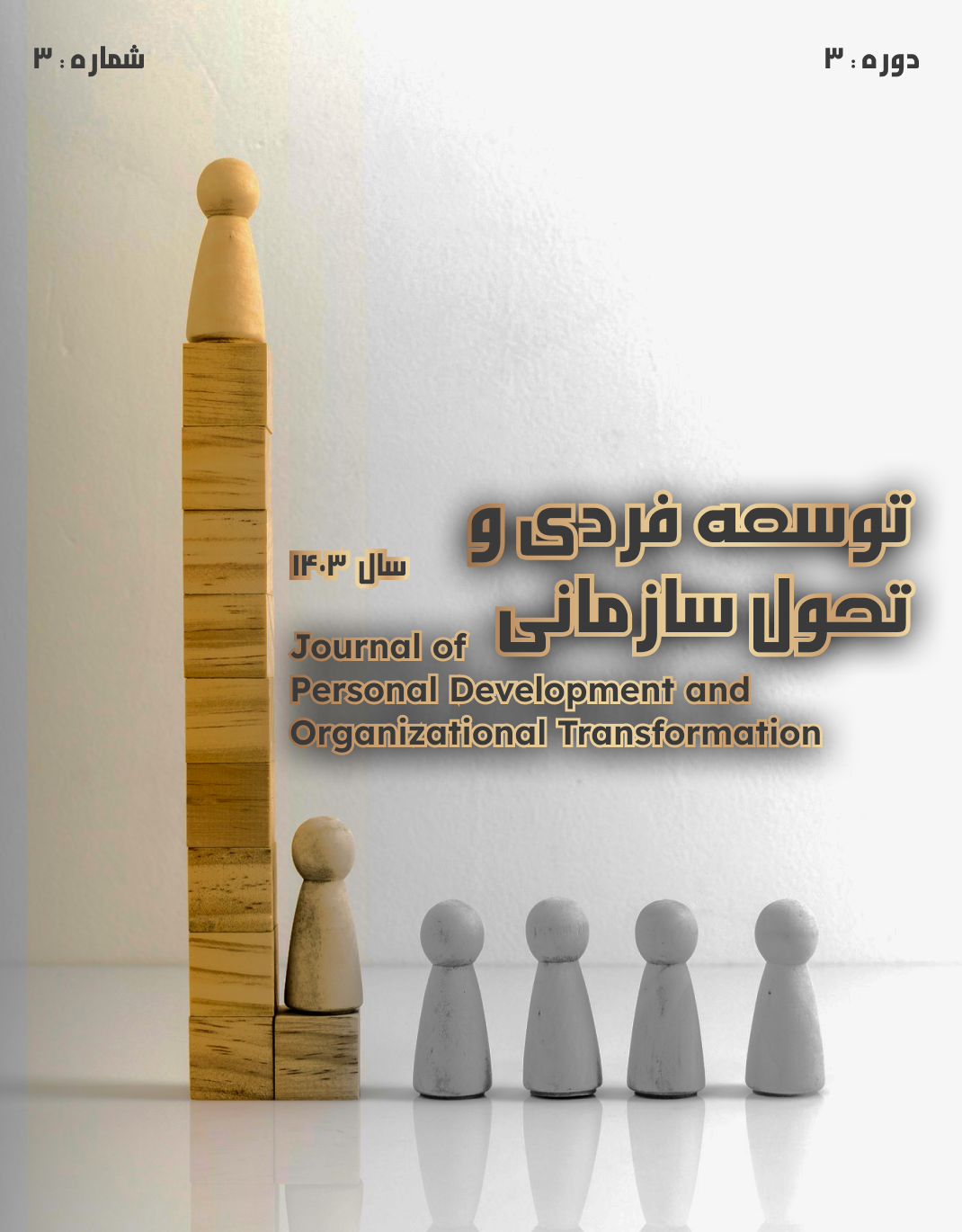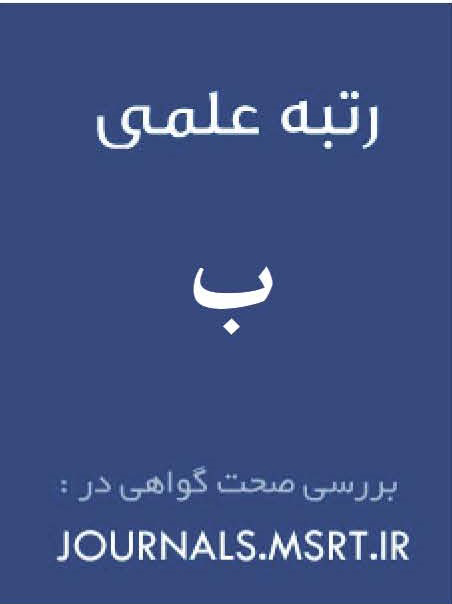بررسی برخی از مؤلفههای جانشینپروری بر مبنای سیستم کاری با عملکرد بالا در شرکت ملی نفت ایران
کلمات کلیدی:
جانشینپروری, سیستم کاری, ساختار سازمانی, مدیریت منابع انسانی, مزیت رقابتیچکیده
با توجه به اینکه جانشینپروری یك استراتژی هوشمند مدیریت استعداد میباشد كه میتواند موجب حفظ استعداد در درون سازمان باشد، این تحقیق به منظور بررسی برخی از مؤلفههای جانشینپروری بر مبنای سیستم کاری با عملکرد بالا در شرکت ملی نفت ایران در سال 1401 انجام پذیرفت. این تحقیق از لحاظ هدف، توسعهای و از نظر نوع دادهها، کیفی و کمی(آمیخته) میباشد. مؤلفههای مورد بررسی از 32 مقاله که مرتبط با موضوع پژوهش بود و نظرخواهی از خبرگان با استفاده از روش دلفی استخراج شد. سپس با استفاده از پرسشنامهای که به تأیید خبرگان سازمانی و دانشگاهی رسیده بود به بررسی میزان سنخیت با نتایج اکتسابی با استفاده از تکنیکهای آماری پرداخته شد. جامعه آماری در بخش دلفی خبرگان و متخصصان سازمان و اعضای هیات علمی دانشگاه و مدیران شرکتهای دولتی و شرکت ملی نفت ایران بودند. ابزار گردآوری دادهها پرسشنامه بود که پرسشنامه اولیه خبرگان 89 گویه بعد از تأیید استاد راهنما و مشاور در دو مرحله بین اعضای پانل تخصصی به تعداد 20 نفر انجام پذیرفت. به منظور اطمینان خاطر از دقیق بودن یافتهها از روایی محتوا و برای پایایی آن از ضریب اعتباریابی کاپا استفاده شد. هریک از گویهها در مقیاس 5 درجهای لیکرت به صورت کاملاً موافقم: 5، موافقم: 4، متوسط: 3، مخالفم: 2 و کاملاً مخالفم: 1 طراحی گردید. تحلیل دادهها با روشهای آمار توصیفی و استنباطی از طریق نرمافزار آماری SPSS شماره 26 انجام گرفت. بر اساس نتایج حاصله عوامل ساختاری – زمینهای شامل شاخصهای ساختار سازمانی، مدیریت منابع انسانی، ذینفعان، سیاستها و قوانین، مزیت رقابتی تعیین گردید. بنابراین نتایج میتوان گفت جانشینپروری برای مشاغل استراتژیک سازمان انجام میشود و مشاغل حیاتی و کلیدی معمولاً 20 درصد از مشاغل سازمان را در بر میگیرد.
دانلودها
مراجع
Alvani, S. M., Seyed Naqvi, M. A., & Zareh Bozorg Abadi, R. (2016). The role of core competencies in succession planning. https://civilica.com/doc/1288467
Amirkhani, A., Nazeryani, M., & Faraz, M. (2016). The Effect of Succession Planning on the Employees' Performance based on the Balance Score Card with Regard to the Mediating Role of Commitment. Research Journal of Management Reviews, 2(1), 42-51.
Bika Zadeh, J. (2023). Modeling the impact of authentic leadership and organizational mentorship on organizational voice with the mediating role of ethical competence in public libraries of East Azerbaijan Province. Quarterly Journal of Information Research and Public Libraries, 27(2), 261-292. https://www.google.com/url?sa=t&source=web&rct=j&opi=89978449&url=https://publij.ir/article-1-2322-fa.html&ved=2ahUKEwigk9W-vo2OAxUh8LsIHWtPDiIQFnoECBUQAQ&usg=AOvVaw0YKqX6wE2LWZ-TPpZJdX6X
Graziadio, G. L. (2015). A human resource perspective on the development of workforce agility A Research Project Presented to the Faculty of The George L. Graziadio School of Business and Management Pepperdine University].
Henseler, J., Ringle, C. M., & Sarstedt, M. (2015). A New Criterion for Assessing Discriminant Validity in Variance-based Structural Equation Modeling. Journal of Academy of Marketing Science, 43(1), 115-135. https://doi.org/10.1007/s11747-014-0403-8
Hosseini, S. H., Barzoki, A. S., & Isfahani, A. N. (2018). Designing a model of succession management system and explaining its impact on organizational performance (case study: Esfahan Steel Company). International Journal of Business Excellence, 15(3), 335. https://doi.org/10.1504/IJBEX.2018.092573
Jafarpoor, M. S., Najafbeigi, R., & Aghighi, A. (2020). A model for developing succession planning (Case study: Welfare Bank). Human Resource Development and Training, 7(27), 63-93. https://www.google.com/url?sa=t&source=web&rct=j&opi=89978449&url=https://ensani.ir/fa/article/452288/
Kamali, A., Hosseini, S. M., Alimohammadzadeh, K., & Khamseh, A. H. S. (2024). Talent identification and succession planning strategies for the appointment of nursing unit managers: A systematic review. Journal of education and health promotion, 13(1), 485-498. https://doi.org/10.4103/jehp.jehp_2087_23
Karimi, M., Heydarinajad, S., & Mehr Ali Zadeh, Y. (2021). Designing a succession management model in the Ministry of Sport and Youth: A grounded theory approach. https://civilica.com/doc/1405422
Latifi, M., Abdolhosseinzadeh, M. H., & Azarfar, A. (2016). Designing a succession planning model in public organizations through structural-interpretive modeling. Management of Public Organizations, 4(4), 33-50. https://www.google.com/url?sa=t&source=web&rct=j&opi=89978449&url=https://ensani.ir/fa/article/366882/
Mitchell, R., Obeidat, S., & Bary, M. (2013). The Effect of Strategic Human Resource Management on Organizational Performance: The Mediating Role of High‐Performance Human Resource Practices. Human Resource Management, 52(6), 899-921. https://doi.org/10.1002/hrm.21587
Montaghimi, B., Ganjavi, F. A., & Sajadi Hezaveh, S. H. (2023). Designing a competency-based succession planning model for sports managers with a qualitative approach. Strategic Studies in Sports and Youth, 22(60), 47-60. https://doi.org/10.22034/ssys.2022.1651.2157
Moradi Shirazi, A., Gholipour, A., & Abouei Ardakan, M. (2013). Designing a succession planning system model for key positions in the Engineering Design and Parts Supply Company of Iran Khodro (SAPCO) Master's thesis, Faculty of Management, University of Tehran].
Muadınohamba, J. L., & Maseke, B. F. (2024). A Framework for Ensuring Effective Executive Succession in Namibian Commercial Public Enterprises. Trends in Business and Economics, 38(1), 56-67. https://doi.org/10.5152/TBE.2024.23190
Ravichandran, T. (2017). Exploring the relationships between IT competence, innovation capacity and organizational agility. Journal of Strategic Information Systems, 27, 22-42. https://doi.org/10.1016/j.jsis.2017.07.002
Richardson, R., & Thompson, M. (1999). The Impact of People Management Practices on Business Performance: A literature review. Institute of Personnel and Development, London. https://www.researchgate.net/profile/Marc-Thompson-2/publication/240314661_The_Impact_of_People_Management_Practices_on_Business_Performance_A_Literature_Review/links/00b4953bfb21358aa3000000/The-Impact-of-People-Management-Practices-on-Business-Performance-A-Literature-Review.pdf
Sadighi Avansar, S. (2023). Examining the relationship between work ethic, learning, and succession planning with job stress and organizational commitment among employees. Proceedings of the 5th National Conference and 2nd International Conference on New Management Patterns in Unstable Conditions, https://civilica.com/doc/1780328
Saha, N., Gregar, A., & Sáha, P. (2017). Organizational agility and HRM strategy: Do they really enhance firms' competitiveness? International Journal of Organizational Leadership, 6, 323-334. https://doi.org/10.33844/ijol.2017.60454
Salimi Bazneshini, S., Hosseini Golafshani, A., Rahman Nasht, H., & Rabiei, M. (2022). Providing a competency model for talent identification and succession planning in the National Gas Company. Strategic Studies in Oil and Energy, 13(Summer), 53. https://www.google.com/url?sa=t&source=web&rct=j&opi=89978449&url=https://iieshrm.ir/article-1-1394-fa.html&ved=2ahUKEwjBpNCAwI2OAxXbX_EDHZVdBjAQFnoECBoQAQ&usg=AOvVaw0s65rdb-7YvW2HoL4cZDz7
Shahabi, M. (2024). Presenting a Succession Model in Government Organizations Using Thematic Analysis. Scientific Journal of New Research Approaches in Management and Accounting, 8(30), 79-97. https://journals.iau.ir/article_688249.html
Tabatabai Moghadam, F. (2010). Investigating dysfunctions in succession planning at the senior management level Master's thesis, Faculty of Management, University of Tehran].
Taleghani, M., Alizadeh, E., Peikarnegar, A. H., & Mehdizade, M. (2023). Designing a Comprehensive Model of Succession in the Country’s Management System with a Meta-Synthesis Approach. Journal of Human Capital Empowerment, 6(1). www.magiran.com/p2628132
Villalpando, D., Campbell, R. J., & Pérez-Nordtvedt, L. (2025). The Time to Succeed: CEO Appointment Phase Entrainment and Post-Succession Firm Operational Performance. SAGE Journals. https://doi.org/10.1177/01492063241311853
Zhang, Z., & Sharifi, H. (2007). Towards Theory Building in Agile Manufacturing Strategy: A Taxonomical Approach. Ieee Transactions on Engineering Management, 54(2), 351-370. https://doi.org/10.1109/TEM.2007.893989
دانلود
چاپ شده
ارسال
بازنگری
پذیرش
شماره
نوع مقاله
مجوز
حق نشر 2025 Abbas Karami (Author); Ghanbar Amirnejad; Ali Reispour, Ezzatollah Kiani (Author)

این پروژه تحت مجوز بین المللی Creative Commons Attribution-NonCommercial 4.0 می باشد.







